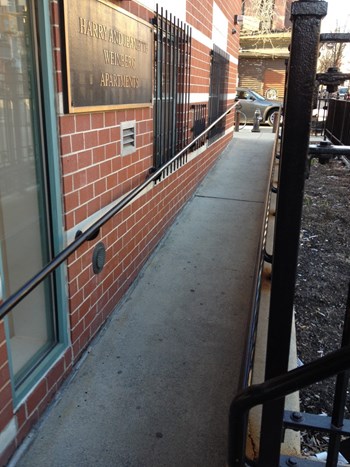
For some New Englanders, planning daily errands and activities can be as tricky as mountaineering. These folks live with disabilities, are elderly, or have had their mobility compromised by illness or injury—even temporarily. For them, getting into or out of their own buildings can seem a monumental task...like climbing a mountain.
Fortunately, there are laws in place intended to provide protection and help make daily life a little bit easier for those living with disabilities. Two in particular—Title III of the Americans with Disabilities Act of 1990 (ADA) and the Fair Housing Amendments Act of 1988 (FHAA)—were designed to compel owners of certain buildings to ensure that people with disabilities have access equal or similar to that available to the general public.
Serious Business
According to attorney Joseph Saurino of Marcus, Errico, Emmer & Brooks, PC in Braintree, Massachusetts, a resident requesting accommodation for a disability is not something that should ever be taken lightly. “Every claim by a resident that he or she needs a special accommodation in connection with a condominium’s rules, policies, or services due to an alleged handicap—whether physical or emotional—must be taken very seriously,” he says. “The failure to respond appropriately in these situations may expose even well-intentioned boards and their property managers to harsh consequences of applicable state or federal anti-discrimination laws, or both.”
‘Reasonable accommodation‘ under the ADA or FHAA can be structural, such as putting in a ramp at the primary entrance to provide wheelchair/walker access, or installing grab-bars in public/community bathrooms. It can also involve policy or rule changes, such as permitting a disabled tenant to have a service or companion animal despite a building’s ‘no pets’ policy, or allowing them—sometimes at their own expense—to make certain structural alterations to allow or improve accessibility. The laws provide guidance in assessing requests for reasonable accommodation, taking into account the nature and cost of the proposed accommodation and the financial resources of the landlord or building.
Interpretation of the Law
As with many laws however, deciphering the language of accessibility can be complicated, and misinterpretation can result in accidental non-compliance. For example, in some cases, managers and trustees in older or historic buildings may believe incorrectly that they are exempt from accessibility requirements. Others may be baffled by the technical requirements of these laws, and still others are resistant to accessibility issues because they assume they automatically imply huge capital expenditures.
Of all these concerns, the biggest question that many have is how far their building or community must to go provide ‘reasonable’ accommodations. “Unfortunately, there are no bright-line tests to establish ‘reasonableness,’” says Saurino. “Rather, the balancing test typically boils down to weighing the costs and other hardships to the association in meeting the request against the requesting resident’s need for the accommodation in order to use and enjoy the condominium.”
According to another attorney, “The statute itself is broad, but the accessibility guidelines do provide a lot of specifics [and] must be reviewed very carefully... the guidelines regulate even the placement of ATMs, saunas, steam rooms, laundry rooms. The goal is to make it so that most people with disabilities are able to utilize the facilities of the building.”
Though these guidelines are in place to insure accessibility, that doesn’t necessarily mean that a building must undertake massive renovations to address every situation named in the statute. Sometimes it falls to the resident to pay for certain alterations. “Whether a community association is required to expend funds to construct a chair-lift in order accommodate a disabled member must be analyzed under federal, state and local law,” says attorney Ronald L. Perl, who is with the New Jersey-based law firm Hill Wallack, LLP. “In the case of Thompson v. Westboro Condominium Association in 2006, the court held that the FHAA does not require a condominium association to construct a disability access ramp at its expense. In that situation, a disabled resident requested that the association construct a wheelchair/scooter ramp to permit her access. The court determined that an association is not required to construct new facilities to accommodate a disabled resident, but that the [resident] could install a ramp at her own expense.”
Perl adds that even if an association or building owner is not required by law to install a ramp, lift, or make other modifications for a disabled resident, the trustees may undertake the project in order to monitor and oversee a project being done on the community’s property. “They may wish to ensure that any modifications done are in accordance with the law,” he says, “However, a written agreement should be obtained prior to any action being taken by an association. It’s also important to remember that state and local laws vary, and may result in a different answer. The association should always consult with their local counsel when it comes to requests for accommodation.”
Help for All
In spite of the fact that there are specific federal and state laws guaranteeing equal access, some managers and building owners drag their feet when it comes to making required alterations for disabled residents. This leads to dissatisfied unit owners, possible litigation and hefty fines. To help avoid these things and make the process smoother, there are many municipal and state-based organizations and offices where residents, management and trustees can turn to for assistance and help in complying with the ADA and FHAA. The New England ADA Center (www.neadacenter.org) is an excellent place to start.
“A first violation of the federal Fair Housing Amendments Act may result in a fine of up to $11,000,” says Saurino. “Subsequent violations may result in fines ranging between $27,500 and $55,000 under the federal statute—not including a claimant’s actual damages. Violations of Massachusetts’ anti-discrimination laws may also result in similarly harsh consequences—or even worse. And reported settlements in these types of cases have run into the hundreds of thousands of dollars. So this is very serious stuff.”
In disputes over accessibility, state or municipal disability advocates try to intervene before formal complaints and litigation come into the picture. The position of these organizations is that the individual requiring accommodation should receive it as soon as possible, so advocates try to reach out to the building management, owner or board of trustees formally in writing to request that the building be made accessible.
In doing this, an advocacy organization will also generally review the case to verify the resident’s need, and whether the requested accommodation is reasonable—both financially and physically—for the building or association to make. If the accommodation is determined to be reasonable, but the building administrators refuse to comply, the case is then referred up to that particular state’s Human Rights Commission, which may then initiate a formal investigation.
In the rare event that a legitimate request continues to be refused, the case may be sent to the Department of Justice (DOJ), which relies on a group known as the Key Bridge Foundation to mediate a solution. The foundation is a non-profit organization underwritten by the DOJ and organized to handle complaints filed with the DOJ under Title III of the ADA.
According to the DOJ website, courts may levy civil penalties only in cases brought by the DOJ—not by private litigants. The department only seeks such penalties when the violation is substantial and the business has shown bad faith. This can take many forms, including hostile acts against people with disabilities, a long-term failure to inquire about what the ADA requires, or sustained resistance to voluntary compliance.
Compliance 101
One point the pros stress when it comes to equal access is that it’s important to remember that accommodations and compliance don’t always have to involve high-tech equipment or great expense— sometimes common sense and a neighborly spirit go a long way. The Institute for Human Centered Design in Boston produces an ADA Checklist for buildings that includes concrete, yes/no questions for building owners and administrators about their property’s compliance, as well as simple solutions to correct noncompliance. For example, “If the main entrance is not accessible, is there an alternative accessible entrance? Do all inaccessible entrances have signs indicating the location of the nearest accessible entrance?” If not, the checklist advises building administrators to “install signs on route before people get to inaccessible entrances so [they] do not have to turn around and retrace their route.”
As more Baby-Boomers age and require accommodations in order to enjoy their homes and common areas, ADA compliance may soon become a non-issue. The demand for accessible housing will increase and ADA-compliant features can be used as strong marketing tools to a 55-and over population.
Many developers and building managers understand that it’s in their own best interest to provide accommodations for disabled unit owners. In doing so, they not only raise the sense of community in their buildings but also let all residents know that they’re valued—regardless of their mobility.
J.M. Wilson is a freelance writer and a frequent contributor to New England Condominium. Associate Editor Hannah Fons contributed to this article.






Leave a Comment